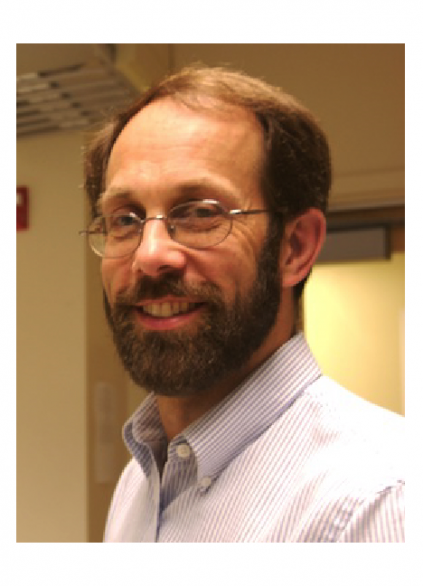Brian Frederick
Professor of Chemistry
Appointments:Professor, Frontier Institute for Research in Sensor Technologies
Professor, Forest Bioproducts Research Initiative
Address: 5708 ESRB-Barrows, Room 257
Telephone: 207.581.2268
Email: briangf@maine.edu
Education: 1991 Ph. D. Cornell University
Professor Frederick investigates fundamental surface chemical processes that occur on sensors, heterogeneous catalysts, and photocatalysts. His research group utilizes a variety of experimental and theoretical methods, including in-situ spectroscopic and high pressure catalyst characterization methods, surface science techniques, quantum chemical calculations and statistical simulations. Research within the UMaine Catalysis group involves physicists, chemists, and chemical engineers working on conversion of biomass into fuels and chemicals, understanding electronic structure in photocatalysts, and probing the factors that control selectivity and transduction in chemical sensors.
Recent Publications:
- Amir Rahmani Chokanlu, Akbar Mahdavi-Shakib, Liping Yu, Thomas J. Schwartz, Rachel N. Austin, Brian G. Frederick, “Direct Evidence for Sulfur-induced Deep Electron and Hole Traps in Titania and Implications for Photochemistry,” Journal of Physical Chemistry C, 127 (2023) 6754-6767. 10.1021/acs.jpcc.3c00526
- Stoltz, Robert M.; Mahdavi-Shakib, Akbar; Frederick, Brian G.; Mirica, Katherine A., “Host-Guest Interactions and Redox Activity in Layered Conductive Metal-Organic Frameworks,” Chemistry of Materials, (submitted Feb. 28, 2020; accepted July 6, 2020). https://dx.doi.org/10.1021/acs.chemmater.0c01007
- Abdulrazzaq, Hussein T.; Rahmani Chokanlu, Amir; Frederick, Brian G.; Schwartz, Thomas J., “Reaction Kinetics Analysis of Ethanol Dehydrogenation Catalyzed by MgO–SiO2” ACS Catalysis, 10 (2020) 6318- 6331. https://doi.org/10.1021/acscatal.0c00811.
- Banerjee, Soham; Zangiabadi, Amirali; Mahdavi-Shakib, Akbar; Husremovic, Samra; Frederick, Brian; Barmak, Katayun; Austin, Rachel; Billinge, Simon, “Quantitative structural characterization of catalytically active TiO2 nanoparticles”, ACS Applied Nano Materials, 2 (2019) 6268-6276. https://doi.org/1021/acsanm.9b01246.
- Mahdavi-Shakib, Akbar; Arce-Ramos, Juan; Austin, Rachel; Schwartz, Thomas; Grabow, Lars; Frederick, Brian, “Frequencies and Thermal Stability of Isolated Surface Hydroxyls on Pyrogenic TiO2Nanoparticles”, Journal of Physical Chemistry C 123 (2019) 24533-24548. https://doi.org/1021/acs.jpcc.9b05699
- Akbar Mahdavi-Shakib, Samra Husremovic, Sohee Ki, Jessica Glynn, Lauren Babb, Janine Sempel, Ioannis Stavrinoudis, Juan M Arce Ramos, Ryan Nelson, Lars C Grabow, Thomas J Schwartz, Brian G Frederick, Rachel Austin, “Titania surface chemistry and its influence on supported metal catalysts”, Polyhedron 170 (2019) 41-50. https://doi.org/10.1016/j.poly.2019.05.012
- Aravind Reghu, L. Jay LeGore, John F. Vetelino, Robert J. Lad, Brian G. Frederick, “Distinguishing Bulk Conduction From Band Bending in Chemiresistive Metal Oxide Gas Sensors,” Journal of Physical Chemistry C, 122 (2018) 10607-10620. DOI: 10.1021/acs.jpcc.8b01446.
- Anushka E. Vithanage, Emtias Chowdhury, Luz D. Alejo, Paige Pomeroy, William J. DeSisto, Brian G. Frederick, William M. Gramlich, “Renewably Sourced Phenolic Resins From Lignin Bio Oil,” Journal of applied Polymer Science, 134 (2017) 44827. https://doi-org.prxy4.ursus.maine.edu/10.1002/app.44827
- Jincy Joseph, Matthew Rasmussen, James Fecteau, Sally Kim, Hyunji Lee, Katelyn Tracy, Bruce Jensen, Brian G. Frederick, Elizabeth Stemmler, “Compositional Changes to Low Water content Bio-oils During Aging: An NMR, GC/MS, and LC/MS Study,” Energy & Fuels, 30 (2016) 4825, 10.1021/acs.energyfuels.6b00238
- Ryan C. Nelson, Byeongjin Baek, Pamela Ruiz, Ben Goundie, Ashley Brooks, M. Clayton Wheeler, Brian G. Frederick, Lars C. Grabow, Rachel Narehood Austin, “Experimental and Theoretical Insights into the Hydrogen-Efficient Direct Hydrodeoxygenation Mechanism of Phenol over Ru/TiO2,” ACS Catalysis, 5 (2015) 6509.
Updated: June 2024

